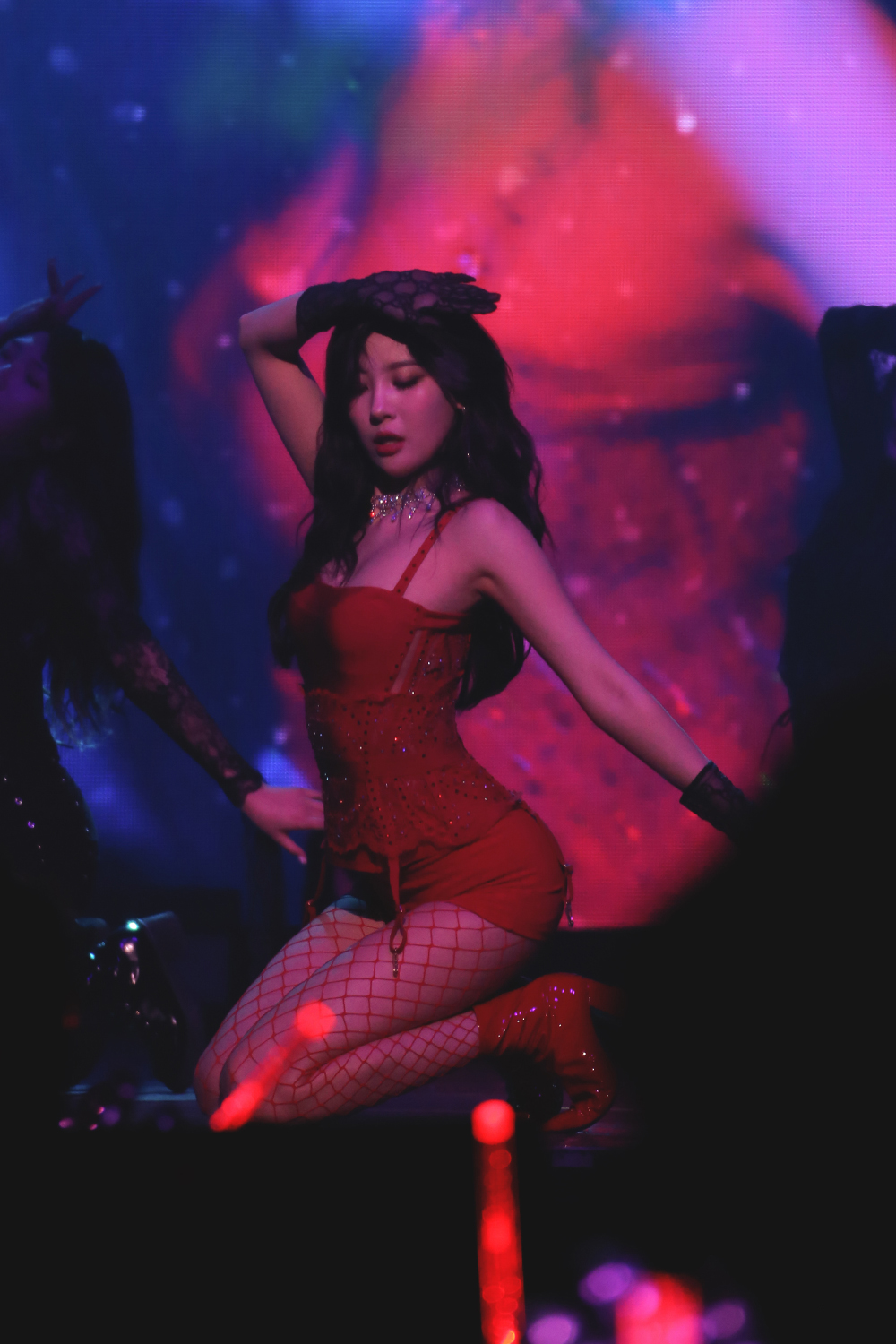You can’t talk about Sunmi without talking about colors. She’s absolutely enamored by them, pours them into her work, and thinks of them in abstract terms, particularly as extensions of one’s personality. To her, finding her own colors is paramount for knowing who she is. It’s a constant process that makes up for much of her creative exploration: “I’m still unsure how I’m going to unwrap and express my different colors. I just know that I want to show a variety of [them].”
Don’t take it at face value, though. A look through Sunmi’s solo work clarifies that each “color” is almost a crude, distilled version of an emotion. Complexities are added over the course of the music, as she leaves fingerprints of her color all over the work, engaging in dialogue with herself to understand her heart better.

Take, for example, the paradoxically titled music video for her latest, “Noir.” Offsetting the dazzling red and yellow heart-shaped candies and moonlight silver dresses is Sunmi herself, playing a protagonist who slowly devolves into a shell of herself as her internet popularity skyrockets. There’s a borderline tangible, subcutaneous terror about it: sunlight yellow and neon greens dot the background as she jumps on a bed of spikes, cuts off a finger as a game, and holds a live wire while dousing herself in water. As the “likes” go up, her sanity takes a nosedive. She calls it the contemporary version of a noir.
“I’ve read about how every year the number of people losing lives while taking crazy and dangerous pictures just to get ‘likes’ from other people is increasing,” she explains. “Despite that, social media keeps on getting bigger. I think of this as a noir.”
True to her interpretation, loneliness pervades the music video. At all times, Sunmi dominates the screen, pointing towards the hovering “Like, share, and subscribe” buttons. The only indication of a foreign presence is the number of “hearts” leaping forward — the modern internet experience, where we’re all speaking into an endless void under the pretext of a community.
“Black, ominous, gloomy. Noir is dark. However, social media is extremely colorful and diverse,” she explains. “The more I think about these two contrasts, the more I feel that it’s ironic.”
Of course, the knowledge of her position as one of South Korea’s most famous stars is not lost on her. “I am not criticizing the reality in any way,” she explains. “In a way, entertainers are those who need the most attention from the audience. It has a somewhat self-mocking meaning.”
It’s understandable, then, why “Noir” came at the time it did. After 12 years, Sunmi is well-versed in the mechanics of the Korean pop industry. She debuted under JYP Entertainment in 2007 as one-fifth of Wonder Girls. With a retro-inspired aesthetic that soon became their trademark, the quintet went on to become one of the most successful K-pop girl groups of the late 2000s, becoming the first K-pop act ever to break the Billboard Hot 100 with the English version of their single “Nobody.”
While she’s veered towards dancehall and electronic elements as a solo artist, 80s synth-pop remains a staple in her musical inspirations, which she credits to the Wonder Girls’ artistry and theatricality. “When I was part of the Wonder Girls, I listened to a lot of music from the ’70s to ’90s. Among them, I found the sounds from the ’80s very attractive.”

Following a short hiatus from show business to focus on her studies and the release of her solo album in 2013, Sunmi finally went solo in 2017 following Wonder Girls’ disbandment. The newfound freedom was a double-edged sword: on the one hand there was the excitement of immersing herself in the production process, and on the other was the urge to discern what kind of artist she wanted to be before moving forward. In a 2018 interview for High Cut magazine, while reminiscing about the time leading up to the conception of “Gashina” — her first single as a soloist — she admitted that she only started to recognize her true self after she went solo.
“It was important to know who I was; my emotions were very suppressed,” she describes the process of finding her color. “I decided to be very honest with myself. Freely express my emotions in front of the camera. Things I wanted to show and express were clearly visible to the audience: frowning, laughing, crying, angry, cursing, making strange faces — they are all Sunmi.”
“Gashina,” thus, was the culmination of a long introspection — vibrant, daring, wild, and liberated from self-imposed chains. Comparing herself to a flower that’s blooming, she cemented her rebirth as a different artist, in the process becoming one of K-pop’s most prolific ingenues.
Looking back, she was “never scared” of putting too much of her colour into “Gashina”: “I didn’t want to be a second someone. I wanted to carve out a genre called ‘Sunmi,’” she says. “I think I was able to express that very well through ‘Gashina,’ ‘Heroine,’ ‘Siren,’ and ‘Noir.’”
Barring “Noir,” the three tracks formed a trilogy that became the bedrock of her first solo album, Warning, released in 2018. It’s an intimate diary, chronicling a relationship gone sour and subsequent recovery from the heartbreak. Between the woeful longing on “Secret Tape” and the triumphant exaltation of one’s true self on “Gashina,” Sunmi carved out a niche that became her trademark, characterized by clever wordplay, endearing theatricality, and emotions laid bare.
“‘Gashina’ and ‘Heroine’ were about finding myself and the process of accepting who I am,” she explains.“ WARNING was literally warning the audience… about emotional things. Don’t be afraid to accept different emotions. Be honest with yourself and it will make everything a little easier.”
As she wraps up her first stateside tour and heads to Europe, she admits that the primary reason for choosing to tour now was to “make the audience curious.” The constant back-and-forth with her emotions, thus, has a purpose. It helps her come face to face with aspects of her inner self — the “identity of the artist called Sunmi.”
“When it comes to facing my inner-self, I’ve learned that I’m always on the border. The importance of this has been the same ever since the release of ‘Gashina,’” she explains. “It’s one of the many answers to the question, ’Who are you?’”
